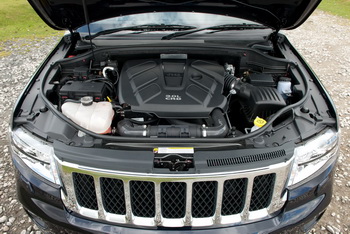 |
|
Jeep already builds the 3.0 VM-engined Grand
Cherokee (above) at the JNAP facility for
the European market. However, the engine
will be modified to meet the US' emissions
standards, in particular for NOx, which are
stricter than European requirements. |
|
|
|
Chrysler
Group is adding a third shift and 1,100 new jobs to its
Jefferson North Assembly Plant in Detroit (JNAP), and
expanding the Jeep Grand Cherokee lineup to include
manufacture of the VM Motori-powered diesel version for
the North American market.
Jeep already builds the 3.0 VM-engined Grand Cherokee at
the JNAP facility for the European market. However, the
engine will be modified to meet the US' emissions
standards, in particular for NOx, which are stricter
than European requirements.
Chrysler Group has also reaffirmed plans to add
150 jobs by reopening its Conner Avenue Assembly Plant,
also located in Detroit for production of the
next-generation Viper.
“Our future, like the history of our brands, is
interwoven with the City of Detroit,” says Chrysler
Group Chairman and CEO Sergio Marchionne. “Detroit long
has been home to renowned innovators and craftsmen. So
it is in the Motor City, home of our industrial heritage
and a resilient people, that we are entrusting the
manufacture not only of the ultimate American sports
car, the SRT Viper, and the Jeep Grand Cherokee – the
most awarded SUV ever – but also a diesel version of the
Jeep Grand Cherokee for North American markets. We
believe that investing in Detroit is not only the right
thing to do, but it is a smart thing to do as we work to
write the next chapter in our shared history,”
Marchionne said.
“We are pleased to have Chrysler Group acknowledge the
contributions of the UAW here in the Motor City by
relying on our workforce to produce two of its most
acclaimed vehicles,” said General Holiefield, UAW Vice
President-Chrysler Department. “Our workers nationwide
have had a rough couple of years along with the American
auto industry and we are proud to be partners in
building a future of success starting right here in
Detroit.”
The new third shift of approximately 1,100 jobs that
Chrysler Group is adding at JNAP, home of the Jeep Grand
Cherokee and the Dodge Durango, will be part of an
operating pattern, called the 3-2-120 schedule, that
allows each employee an additional 49 days off per year
while enabling the plant an additional 49 days of annual
production.
JNAP was the first Chrysler Group plant in Michigan to
add a second shift of production, or about 1,100 jobs,
in July 2010. It also was the first Chrysler Group plant
to add new hires to its ranks. Current employment at the
plant is approximately 2,890.
The new job announcement builds upon Chrysler Group’s
existing commitment, announced last month, to reopen the
Conner Avenue Assembly Plant to produce the
next-generation Viper, which will this time around be
badged as an "SRT" rather than as a Dodge. With Conner’s
reopening, nearly 150 hourly and salaried jobs will
return to the City of Detroit. The new Viper will make
its return to the product lineup late this year. Conner
employees began reporting for training and orientation
towards the end of last year.
|
|
|